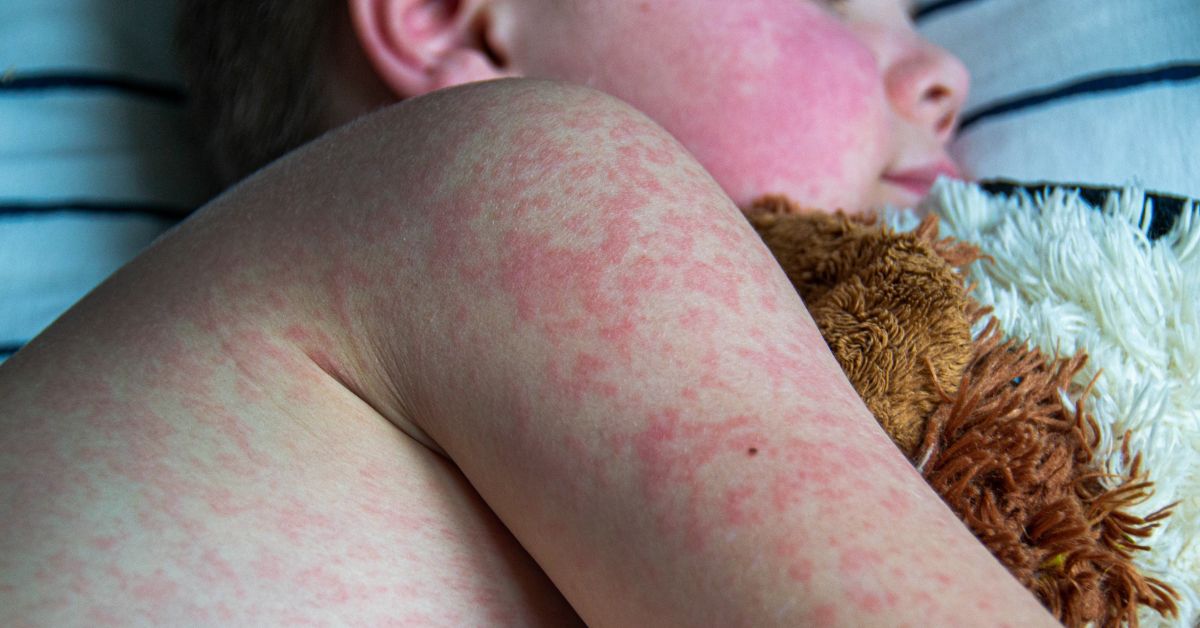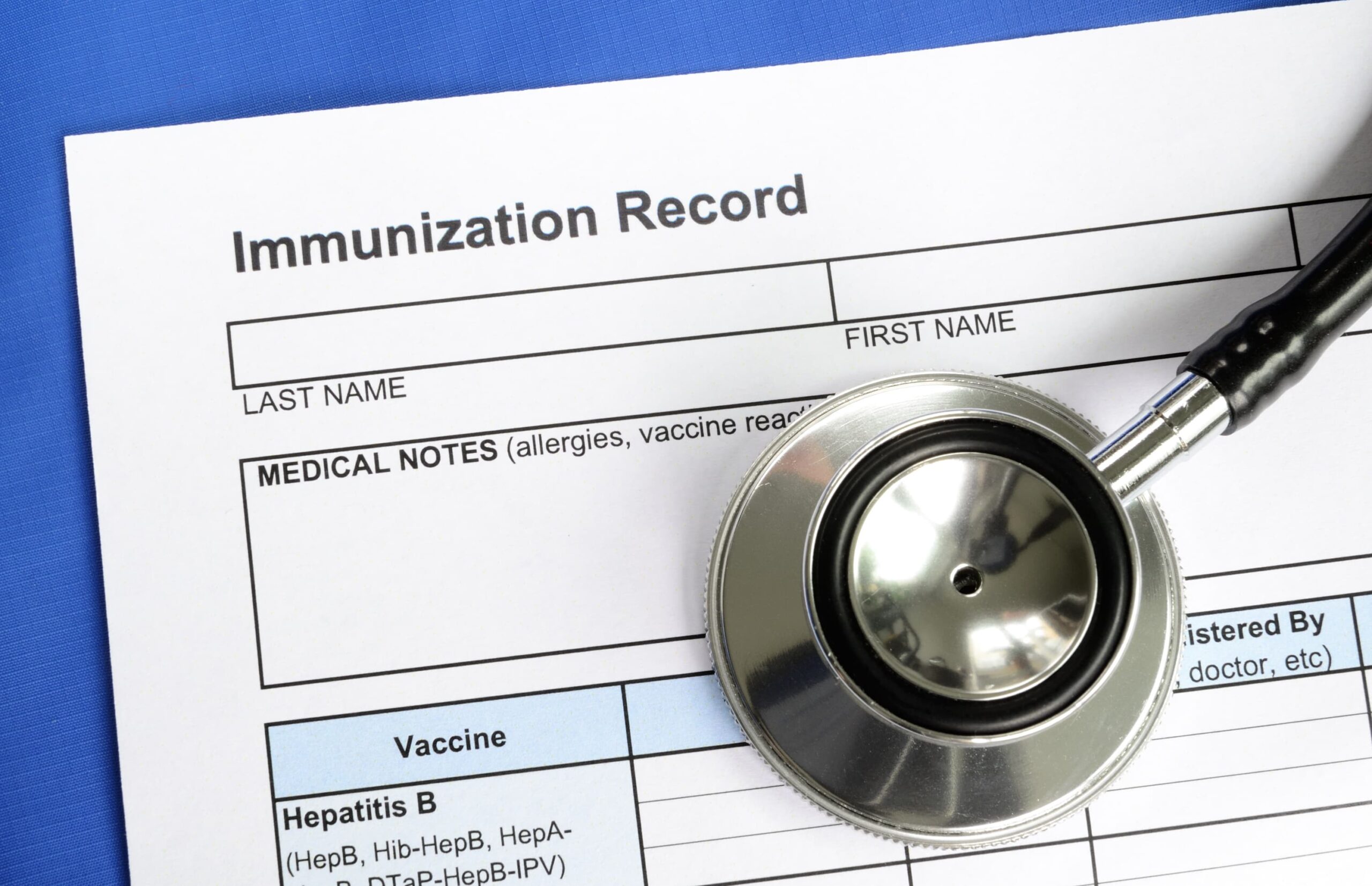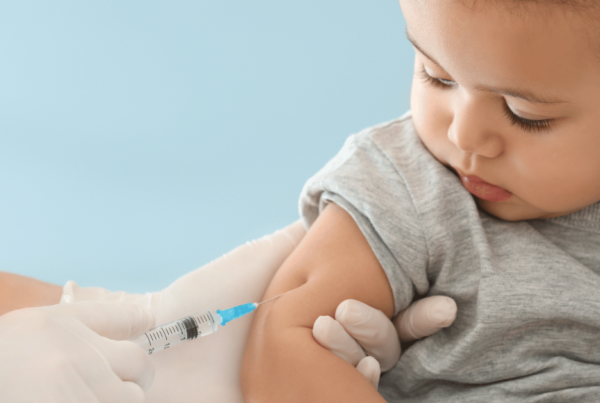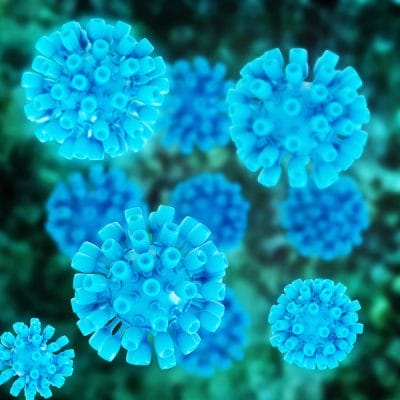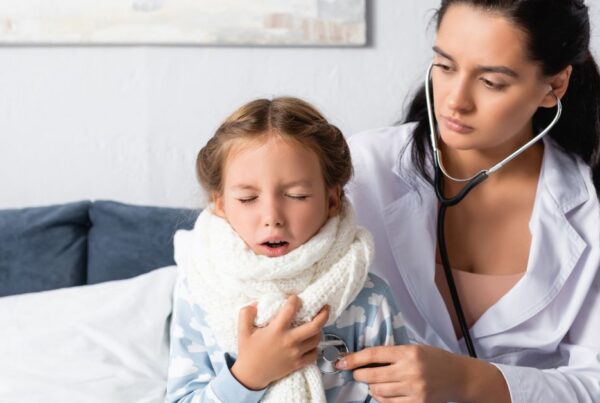As of March 27, 2025, there have been 483 confirmed cases of measles in the U.S. spanning 20 jurisdictions (1). It’s apparent that nobody is 100% safe from contracting measles, whether vaccinated or not. Measles cases have been reported in both groups. This article discusses measles’ symptoms and complications and offers tips for the treatment of mild cases.
Measles Symptoms
Measles is generally a benign illness resulting in bed rest for several days with cold symptoms, including runny nose, cough, fever, rash, and possibly white (Koplik) spots in the mouth.
Measles signs and symptoms appear 10 to 14 days after exposure to the virus.
Signs and symptoms of measles typically include (2):
- Fever
- Dry cough
- Runny nose
- Sore throat
- Inflamed eyes (conjunctivitis)
- Tiny white spots with bluish-white centers on a red background found inside the mouth on the inner lining of the cheek — also called Koplik spots
- Skin rash made up of large, flat blotches that often flow into one another
The infection occurs in sequential stages over a period of two to three weeks.
To learn more about viral rashes in children, read this article: Viral Exanthem Rashes In Children
Infection and Incubation
For the first 10 to 14 days after you’re infected, the measles virus incubates. You have no signs or symptoms of measles during this time.
To learn more about what to do if you’ve been exposed to measles, read these articles: What To Do If You’ve Been Exposed To Measles and What to Do After Exposure to a Sick Person: Immune Support Tips for Families
Nonspecific Signs and Symptoms
Measles typically begins with a mild to moderate fever, often accompanied by a persistent cough, runny nose, inflamed eyes (conjunctivitis), and sore throat. This relatively mild illness may last two or three days.
Acute Illness and Rash
The rash consists of small red spots, some of which are slightly raised. Spots and bumps in tight clusters give the skin a splotchy red appearance. The face breaks out first, particularly behind the ears and along the hairline. Over the next few days, the rash spreads down the arms and trunk, then over the thighs, lower legs and feet. At the same time, fever rises sharply, often as high as 104 to 105.8°F (40 to 41°C). The measles rash gradually recedes, fading first from the face and last from the thighs and feet.
Communicable Period
A person with measles can spread the virus to others for about eight days, starting four days before the rash appears and ending when the rash has been present for four days.
Measles (and MMR) Complications
As with any disease, there are complications with measles: dehydration, diarrhea, pneumonia, encephalitis, eye complications, and death (2).
According to the CDC, there are 2 populations where the above complications of measles usually arise (2):
- Children under 5 years of age.
- Adults 20 years of age and older.
The WHO lists an additional piece of context: Malnourished children, especially those without enough vitamin A or with a weak immune system from HIV or other diseases, are most likely to experience complications (3). The WHO also adds that an active measles infection also weakens the immune system and can make the immune system “forget” how to fight against infection, making infected children especially vulnerable to secondary infections (3).
Children under 5 years of age
According to the CDC, children are to receive the first dose of the MMR vaccine between 12-15 months (2). Supposedly, this dose will confer protection against measles.
What about children under 12 months of age?
Breastfeeding your infant allows natural maternal antibody transfer, keeping them protected from measles for up to one year. Unfortunately, since the introduction of the MMR vaccine, mothers who have been vaccinated for measles as opposed to acquiring the infection naturally, have less antibody transfer from breast milk to protect their vulnerable infant.
In the original version of this article which I published in 2015, I included the below quote from the CDC:
“The mothers of many infants who developed measles were young, and their measles immunity was most often due to vaccination rather than infection with wild virus. As a result, a smaller amount of antibody was transferred across the placenta to the fetus, compared with antibody transfer from mothers who had higher antibody titers resulting from wild-virus infection. The lower quantity of antibody resulted in immunity that waned more rapidly, making infants susceptible at a younger age than in the past.”
This quote is no longer on the website. However, I did find still find research suggesting that that vaccine-induced immunity is less robust than that induced by natural infection (4,5).
Result
Due to the introduction of the MMR vaccine, Mother Nature no longer has the ability to effectively protect the young infant during this critical period when measles complications are highest.
Adults 20 years of age and older
As with chickenpox, measles gets complicated in adults, and symptoms may be more severe. Here’s where it gets interesting. We all know that acquiring wild measles confers lifelong immunity, however receiving the vaccine does not necessarily do this.
In 2015, when I originally published this article, I included the below quote from the CDC. This information is no longer published on their website.
“Relative to earlier decades, an increased proportion of cases (measles) now occur among adults. In 1994, adults accounted for 24% of cases, and in 2001, for 48% of all reported cases.”
Current CDC data shows that there were 285 reported cases of measles in 2024, with 27% occurring in adults aged 20 years and older. As of March 28, 2025, there have been 483 reported cases of measles in 2025, with 23% of those cases occurring in adults aged 20 years and older. The CDC does also state that prior to vaccination, nearly all cases of the measles occurred in children before they turned 15 years old (6).
Malnourished children
“Malnourished children” are at risk for measles complications. We tend to assume we don’t have malnourished children in the U.S. but that isn’t true – as of 2023, 18% of U.S. households with children have experienced food insecurity (7). We know that measles especially affects children with a vitamin A deficiency (3).
Due to strong risk factors for disease, this is the population of individuals that I’d recommend receive the MMR vaccine (just my small professional opinion).
Learn how to support your child’s body during vaccinations: 6 Ways To Support Your Child’s Health On Vaccination Day.
Effective Measles Treatment
Measles is a virus, so we can’t treat it with antibiotics. It’s our immune system’s job to launch the attack and capture the foreign invader. In order to lessen the measles symptoms (and complications) and effectively restore balance in the body, we must give our immune system the ammunition needed to accomplish this task.
Think of treating measles in the same manner we would treat the flu: stimulate the immune system to do its job effectively.
1. Don’t panic.
You got this.
2. Dose with vitamin A.
There are copious studies on the effectiveness of vitamin A as treatment for measles. Vitamin A has long been termed the “anti-infective” vitamin based on the increased number of infections noted in vitamin A deficiency (8).
A study done at Harvard looked at 28,573 children from Sudan between the ages of 6 months and 6 years. Vitamin A intake was strongly correlated with decreased risk of diarrhea, cough, fever, and measles (9). This is important to reduce the risk of complications that can be associated with measles.
Vitamin A also up-regulates immune system activity and stimulates antibody response (10,11).
“The effects on morbidity from measles are related to enhanced antibody production and lymphocyte proliferation. Benefits for severe diarrhea could be attributable to the functions of vitamin A in sustaining the integrity of mucosal epithelia in the gut” (12).
Dosage recommendations of vitamin A set forth by the World Health Organization in 2009, as measles treatment is this:
“A high dose of vitamin A is given immediately on diagnosis and repeated the next day. The recommended age-specific daily doses are 50 000 IU for infants aged <6 months, 100 000 IU for infants aged 6–11 months, and 200 000 IU for children aged ≥12 months” (13).
Currently, their website simply states: “ All children or adults with measles should receive two doses of vitamin A supplements, given 24 hours apart” (14) but does not specify dosage.
Alternatively, vitamin A can be dosed:
- age 6 months- 1 year: 100,00IU in one dose, followed by 100,000IU 4 weeks later
- >1 year old: 200,000IU in one dose, followed by 200,000IU, 4 weeks later (15).
To learn more about dosing vitamin A, read these articles: Vitamin A Megadose For Viral Infections and The Benefits of Vitamin A & Pediatric Dosing
3. Rest.
Encourage bed rest and lounging around (at home of course). Our body recovers at a much faster rate when we give it rest. This may be a good time to offer lazy days and cartoons.
4. Hydrate.
Measles equals fever. Yes, unfortunately there will be a fever involved and possibly diarrhea. It is extremely important to stay hydrated with water and an electrolyte replacement (breast milk for babes). Stay away from “electrolyte drinks” like Gatorade or Powerade (probably Pedialyte also) because they are loaded with sugar and will decrease immune response (see #6). You can make your own electrolyte drink.
Make sure urine remains almost clear and little to no smell. If you notice very yellow smelly urine, it is a sure sign of concentrated urine, or dehydration.
5. Withhold fever reducing medication (when possible).
Fevers happen when the body releases certain chemicals called pyrogens that raise your internal temperature. This increase is part of the body’s natural way of defending itself against illness. When you have a fever, it’s a sign that your body’s healing and immune systems are actively working to fight off whatever is causing harm. To learn more about the fever response, read this article: Fevers 101: Benefits, Home Care Strategies, & When to Medicate
Tepid compresses seem to work well during fever, as well as herbal support.
I’m a mother and I totally understand the helplessness we feel when our children are ill. Fevers can be scary, but generally think in terms of symptoms, not so much the number on the thermometer. Keep checking on the overall appearance, behavior, and attitude of your sick one. Mild to moderate lethargy is normal. Breathing difficulties, vomiting, or severe lethargy are signs of complication and need to be treated right away. If you are worried about febrile seizures, I encourage you to read this article: What Every Parent Needs To Know About Febrile Seizures.
To learn about using fever reducing medications, read these articles: FAQ: Can My Child Take Motrin® or Tylenol® with Temperature Tamer™ or Nature Profen™? And Are Over-The-Counter Painkillers Safe?
6. Avoid Sugar.
Research shows the immune system cannot properly do its job in the presence of sugar:
“The decrease in phagocytic index was rapid following the ingestion of simple carbohydrates. The greatest effects occurred between 1 and 2 hr postprandial, but the values were still significantly below the fasting control values 5 hr after feeding” (16).
To learn more about supporting the immune system, read this article: Winter Immune Support For All Ages
7. Nourish the body with nutrient rich foods.
Typically we think of chicken soup when fighting viruses such as the flu, or in this case, measles. The most nutrient rich food that comes to my mind is homemade bone broth! It’s super easy to make and easy to digest. Also, think fruits, vegetables, and porridges.
To learn more about the beneficial properties of bone broth, and to get my recipe, read this article: The Benefits Of Bone Broth (And How To Make It Yourself).
8. Use antiviral herbs and herbs to stimulate the immune system.
Some of my favorite antiviral herbs include echinacea and astralagus.
9. Consider homeopathic remedies.
Remember with homeopathic remedies, the patient doesn’t necessarily need to have all the symptoms under the remedy; pick the remedy that fits their case the best.
Aconitum
Useful at the beginning stages of measles when a child has high fever, dry barking cough, pink eye, skin burns, or itches; and feels restless, anxious, and frightened.
Apis
The rash begins but fails to develop fully, then soon disappears, though the child doesn’t feel completely well. The itching is made worse by warmth, and the face and eyelids are puffy.
Belladonna
Useful at the beginning stages of measles where there is sudden onset of high fever, a reddened face, and throbbing headache. The child tends to be drowsy, a little delirious, and has difficulty falling or staying asleep, and despite fever, they are not very thirsty.
Bryonia
Skin eruptions from measles are delayed. Hard, dry cough with no expectoration. Any motion causes pain. The child may experience some mild delirium.
Euphrasia
Fever and rash present. Acrid tears and a bland nasal discharge. Child is sensitive to light. Cough is present but only during the day.
Gelsemium
Onset of symptoms is slow. Fever present. Great weakness and a sense of heaviness of the whole body and specifically the eyelids. There is no thirst.
Kali bic
There is ropy, stringy discharge present from the nose and burning, tearing eyes.
Salivary glands are noticeably swollen and may have stitching pains that go from the ear into the head and neck.
Pulsatilla
Mild case of the measles; fevers are not high. Symptoms are not too painful. Will have profuse tearing from the eyes and considerable nasal discharge. Dry cough at night that becomes loose in the daytime. May have ear inflammation. Although the child has a dry mouth, they aren’t thirsty.
Sulphur
It has a purplish appearance. Itching is aggravated by scratching. Reddened mucus membranes and the child is very thirsty. Cough and diarrhea are at their worst in the morning.
To learn more about using homeopathic remedies, read these articles: How To Use Homeopathic Remedies – A Quick-Start Guide For Families and 10 Homeopathic Remedies For Treating Fevers
When to seek medical care:
- You feel uncomfortable caring for your loved one
- The child is very young
- High fever persists after rash has fully appeared
- Chest pain develops
- Breathing difficulty
- Severe cough
- Seizures or severe headaches
- Loss of consciousness
- Delirium
- Stiff neck
- Severe earache that does not respond to treatment
I hope this helps to ease a bit of the current measles scare. If you’d like to learn more, read these articles: Measles: A Holistic Perspective and What To Do If You’ve Been Exposed To Measles
(Disclaimer: Scientific information presented in this article is for educational purposes only and does not constitute medical advice.)
Reviewed/Updated: 3/2025
References:
- CDC. (2024, May 13). Measles Cases and Outbreaks. Measles (Rubeola). https://www.cdc.gov/measles/data-research/
- CDC. (2024, July 10). Chapter 13: Measles. Cdc.gov. https://www.cdc.gov/pinkbook/hcp/table-of-contents/chapter-13-measles.html
- World Health Organization. (2024, November 14). Measles. World Health Organization. https://www.who.int/news-room/fact-sheets/detail/measles
- Markowitz LE, Albrecht P, Rhodes P, Demonteverde R, Swint E, Maes EF, Powell C, Patriarca PA. Changing levels of measles antibody titers in women and children in the United States: impact on response to vaccination. Kaiser Permanente Measles Vaccine Trial Team. Pediatrics. 1996 Jan;97(1):53-8. PMID: 8545224.
- Mathew JL, Wagner AL, Ratho RK, Patel PN, Suri V, Bharti B, Carlson BF, Dutta S, Singh MP, Boulton ML. Maternally transmitted anti-measles antibodies, and susceptibility to disease among infants in Chandigarh, India: A prospective birth cohort study. PLoS One. 2023 Oct 3;18(10):e0287110. doi: 10.1371/journal.pone.0287110. PMID: 37788252; PMCID: PMC10547151.
- CDC. (2020, November 5). Measles History. Centers for Disease Control and Prevention. https://www.cdc.gov/measles/about/history.html
- USDA. (2025, January 8). Food security in the U.S. – Key statistics & graphics. Usda.gov. https://www.ers.usda.gov/topics/food-nutrition-assistance/food-security-in-the-us/key-statistics-graphics
- Wayback Machine. (2022). Archive.org. https://web.archive.org/web/20150314103840/http://www.uta.edu/faculty/sawasthi/Lecture%20Notes%20Chem1451/Vitamin%20A%20biochemistry.pdf
- Fawzi WW, Herrera MG, Willett WC, Nestel P, el Amin A, Mohamed KA. Dietary vitamin A intake and the incidence of diarrhea and respiratory infection among Sudanese children. Department of Nutrition, Harvard School of Public Health, Boston, MA 02115, USA. The Journal of Nutrition [1995, 125(5):1211-1221]
- Mora JR, Iwata M, von Andrian UH. Vitamin effects on the immune system: vitamins A and D take centre stage. Nature reviews. Immunology2008;8(9):685-698. doi:10.1038/nri2378.
- Ross AC, Chen Q, Ma Y. Vitamin A and Retinoic Acid in the Regulation of B-Cell Development and Antibody Production. Vitamins and hormones2011;86:103-126. doi:10.1016/B978-0-12-386960-9.00005-8.
- Villamor E1, Fawzi WW. Effects of vitamin a supplementation on immune responses and correlation with clinical outcomes. Clin Microbiol Rev. 2005 Jul;18(3):446-64.
- Wayback Machine. (2015). Archive.org. https://web.archive.org/web/20220305200640/http://www.who.int/wer/2009/wer8435.pdf?ua=1
- World Health Organization. (2024, November 14). Measles. World Health Organization. https://www.who.int/news-room/fact-sheets/detail/measles
- J Skowron, NMD. Fundamentals of Naturopathic Pediatrics. CCNM Press. 2009. 194-95.
- Sanchez A, et al. Role of sugars in human neutrophilic phagocytosis. Am J Clin Nutr November 1973 vol. 26 no. 11 1180-1184.
